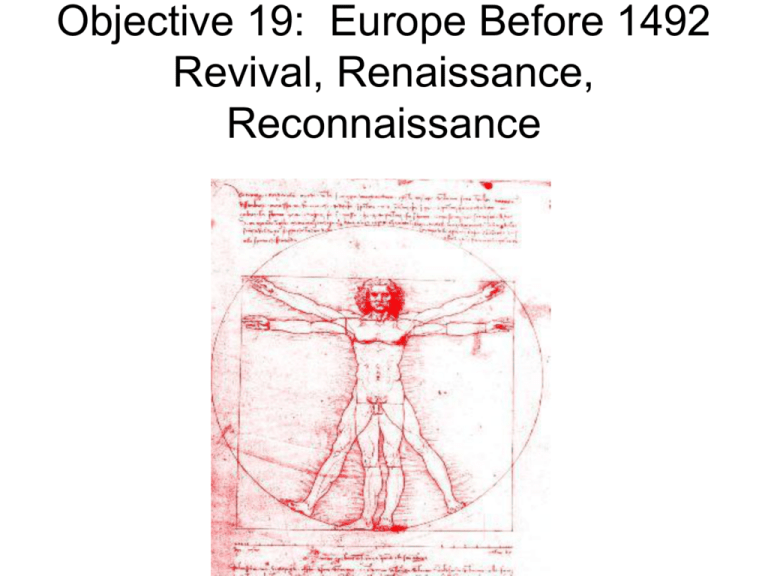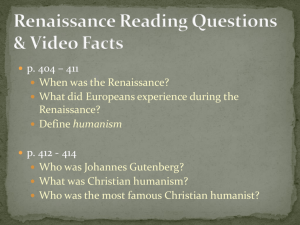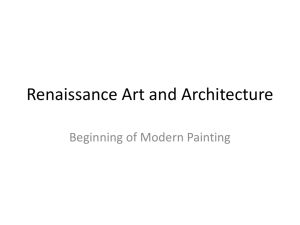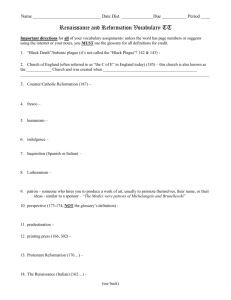Objective 19: Europe Before 1492 Revival, Renaissance
advertisement

Objective 19: Europe Before 1492 Revival, Renaissance, Reconnaissance th 14 century crises • Mongol Invasions • Great Schism • The Plague- 1346-50 • Hundred Years War 1337-1453 The Mongol successor states. After the death of Chinggis Khan’s grandson Mongke in 1259, the Mongol world devolved into four successor states. Kublai Khan’s emerged as the most powerful, but only after a long struggle with Song China. In Central Asia, the Chagatai dominated the eastern steppe; the Golden Horde became established in southwest Russia; and the Il-Khan in Persia ruled from Kabul to Anatolia. The routes of the plague. The central and east Asian stability imposed by Mongol rule— the “Mongol Peace”—brought mixed benefits. Trade flourished, and travelers such as Ibn Battuta and Marco Polo were able to write remarkable accounts of the lands they visited. At the same time, however, vectors for other travelers, such as the rats that carried bubonic plague, also opened up. The Black Death, originating in Central Asia, was one of a succession of plagues that followed the trade routes by land and sea, decimating parts of Europe and China. Consequences of the Plague • Depopulation of Europe • Church lost authority • Erosion of serfdom as the labor shortage enabled serfs to demand wages and better working conditions Population Decline (millions) 100 90 80 70 60 China Europe 50 40 30 20 10 0 1300 CE 1400 CE 1500 CE Hundred Years War 1337-1453 • A conflict between the king of France and England, a vassal state Joan of Arc fought for the French • Triggered by a succession dispute Recovery – 15th century: The end of feudalism and the emergence of Europe • Reintegration into hemispheric trading networks • Resurgence of trade and a money economy • Creation of new towns and cities • Reemergence of monarchies and regional states Long-term consequences of the Hundred Years War • Strengthened monarchies and national armies • New weapons transformed warfare • Political consolidation: France and Britain became independent monarchies Town life • Organization of merchant and craft guilds • Guilds and towns challenged the authority of feudal lords and manors The Renaissance • Renaissance = “rebirth” Humanism, secularism • A 15th century cultural, artistic, and philosophical movement • Centered in powerful city-states of Northern Italy, particularly Florence Brunelleschi’s dome on the cathedral of Florence Renaissance in Italy, 1300– 1570. From 1300–1570 in Italy, artists and intellectuals worked to fuse the Christian tradition (originating in antiquity but developed during the Middle Ages) with the Greco-Roman tradition in a movement fundamental for the later evolution of the modern civilization of the West: the Renaissance. This map shows the principal places that are associated with the names of important figures. Three Stages: Literary and artistic revival Civic Humanism Christian Humanism The recovery of classic texts • Hundreds of Greek and Roman texts were recovered and translated • Recovery of “pagan classics” of secular philosophy as well as religious works Francesco Petrarca [1304-1374] traveled throughout Europe searching for ancient texts Creation of Adam by Michelangelo Michelangelo’s David Pieta by Michelangelo The Sistine Chapel painted by Michelangelo The Last Supper by Leonardo da Vinci Hands sketched by Leonardo da Vinci Mona Lisa by Leonardo da Vinci The growth of universities • Europe’s first universities were built in the 11th and 12th centuries • “Universities” were guilds of scholars and students • Latin was the language of scholarship • 1300 a dozen universities • 1500 almost 100 Explosion in printing and literacy • Introduction of moveable type and printing press c. 1450 • The Gutenberg Bible was the first book in the West printed with moveable type • By 1500 ten million printed books were in circulation in Europe The Gutenberg Press and Bible Reconnaissance European Voyages OBJECTIVES: “God, Gold, Glory”? • To avoid travel over land • To bypass the Middle East and find easy passage to Asia • To enter directly lucrative trade networks in the Indian Ocean • To convert people to Christianity Pepper from the “Spice Islands” was a highly desired commodity in Europe Enabling technologies • Lateen and square sails • Rudders • Magnetic compasses and astrolabes • Knowledge of wind and currents The compass was developed by the Chinese in the 7th century; widely used in Indian Ocean by 11th century The astrolabe measured latitude. Developed by Greeks and Persians, reintroduced to Europe by Arabs Wind and current patterns in the world's oceans. How does Europe rise to world dominance? • • • • • • • • Theory of the “retarding lead” Southernization Economic recovery after the Plague Nation states Rise of capitalism Intellectual growth in the Renaissance Contact with the Mongols Contact with the Muslim Empire through Spain and the Crusades





